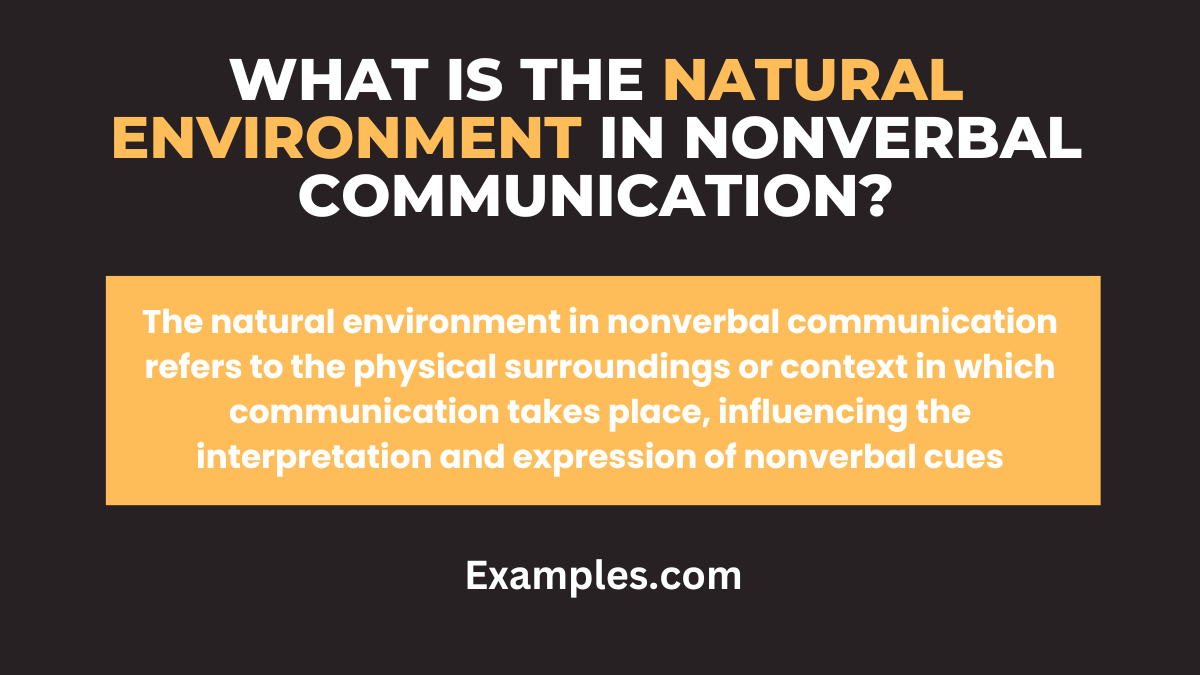29+ Natural Environment in Nonverbal Communication Examples
The concept of the Natural Environment in Nonverbal Communication is intriguing and integral to understanding interpersonal interactions. This guide delves into how our surroundings influence and are interpreted through nonverbal cues. From the rustle of leaves to the ambiance of a forest, natural settings can significantly impact how nonverbal communication is conveyed and perceived.
What is the Natural Environment in Nonverbal Communication?

The concept of Natural Environment in Nonverbal Communication refers to how our surroundings impact and shape the way we communicate nonverbally. Unlike structured environments, natural settings provide unique cues and contexts that influence gestures, facial expressions, and body language. Understanding this interaction is crucial for comprehending the full spectrum of nonverbal communication.
What is the Best Example of Natural Environment in Nonverbal Communication?

- Outdoor Meetings: Conducting meetings in a park or garden, where the calm and scenic environment can lead to more relaxed body language and open communication.
- Nature as a Stress Reliever: In natural settings, individuals often exhibit reduced stress, leading to more genuine and less guarded nonverbal cues.
- Environmental Influence on Group Dynamics: Group activities in natural settings often lead to more cohesive body language, mirroring, and synchronization among members.
30 Examples of Natural Environment in Nonverbal Communication

The natural environment plays a pivotal role in nonverbal communication. It encompasses the unspoken elements that convey messages and feelings in our surroundings. These examples highlight how nature influences our nonverbal interactions
- Sunlight and Mood: Bright sunlight can uplift spirits, enhancing positive nonverbal cues like smiling or open body language.
- Rainy Weather and Emotion: Rain often brings introspective or somber nonverbal expressions, such as a downward gaze or slower movements.
- Landscape Views and Relaxation: Viewing mountains or oceans can induce calmness, reflected in relaxed posture and facial expressions.
- Seasonal Changes and Behavior: Different seasons can affect our nonverbal communication; for example, winter might lead to more subdued and reserved body language.
- Floral Scents and Interaction: The presence of flowers and their scents can subtly influence a more friendly and open nonverbal exchange.
- Garden Spaces and Meetings: Gardens provide a serene setting that can make nonverbal exchanges more open and peaceful.
- Animal Presence and Emotions: Interactions with animals, like a pet dog, can elicit joy and warmth in nonverbal cues.

- Natural Sounds and Listening: The sound of a flowing river or rustling leaves can create a tranquil environment, encouraging attentive nonverbal listening postures.
- Outdoor Temperature and Comfort: Extreme heat or cold can affect our nonverbal behavior, often leading to closed or protective body language.
- Nature Trails and Freedom: Walking in nature can evoke a sense of freedom, mirrored in relaxed and open nonverbal gestures.
- Moon Phases and Mystery: Different phases of the moon can imbue a sense of mystery or contemplation in nonverbal cues.
- Sunsets and Reflection: The calmness of a sunset can lead to reflective and peaceful nonverbal expressions.
- Wildlife and Awe: Observing wildlife can bring out feelings of awe and respect, evident in nonverbal admiration.
- Natural Disasters and Stress: In the face of natural disasters, nonverbal communication often becomes tense and alert.
- Starry Nights and Dreaminess: A clear, starry night can induce a dreamy and whimsical nonverbal demeanor.
- Ocean Waves and Rhythm: The rhythm of ocean waves can sync with our nonverbal rhythms, like breathing or pacing.
- Forest Density and Intimacy: Dense forests can create an intimate setting, affecting nonverbal closeness and personal space.
- Mountain Altitudes and Exhilaration: High altitudes can lead to exhilarating nonverbal expressions, like wide eyes and animated gestures.
- Desert Expanse and Solitude: The vastness of a desert can reflect in nonverbal cues of solitude and introspection.
- Rural vs. Urban Settings: Nonverbal communication differs in rural tranquility versus urban hustle, affecting pace and intensity of gestures.
- Changing Leaves and Transition: The changing colors of leaves in autumn can mirror transitional nonverbal cues, like shifting postures or gazes.
- Water Bodies and Flow: Being near rivers or lakes can influence our nonverbal communication to be more fluid and continuous.
- Weather Patterns and Predictability: Unpredictable weather can lead to uncertain nonverbal signals, like hesitant movements.
- Natural Lighting and Visibility: Different natural lighting conditions can affect the visibility of our nonverbal cues.
- Geographical Location and Diversity: Nonverbal communication varies with geographical locations, reflecting cultural influences intertwined with nature.
- Soil and Grounding: The type of soil or terrain can impact our stance and nonverbal grounding.
- Vegetation and Growth: Lush vegetation can symbolize growth and renewal, influencing optimistic nonverbal expressions.
- Eco-Systems and Interconnectedness: Diverse ecosystems show the interconnectedness of life, mirrored in harmonious nonverbal interactions.
- Climatic Zones and Adaptation: Different climatic zones necessitate adaptation, reflected in adaptable and flexible nonverbal communication.

- Astronomical Events and Wonder: Events like eclipses or meteor showers can evoke wonder and amazement in nonverbal reactions.
Importance of Natural Environment in Nonverbal Communication
- Enhances Authenticity: Natural environments often bring out more authentic nonverbal behavior, as individuals are less constrained by the formalities of indoor settings.
- Improves Mood and Communication: The soothing effect of nature positively influences mood, which in turn enhances the quality and openness of nonverbal exchanges.
- Facilitates Healing and Empathy: Natural settings can aid in therapeutic and counseling sessions, fostering empathy and understanding through more open and relaxed body language.
Incorporating aspects like Facial Expressions in Nonverbal Communication and Body Language in Nonverbal Communication into these environments further enriches our understanding of nonverbal cues. Understanding the interplay between our natural surroundings and nonverbal communication is essential for a comprehensive grasp of human interaction.
How to Use Natural Environment in Nonverbal Communication?
The natural environment plays a significant role in nonverbal communication. Whether in a professional setting or in daily interactions, understanding how the environment impacts communication can enhance the effectiveness of your nonverbal cues.
Understanding the Role of the Environment
The natural environment encompasses the physical setting where communication occurs. This setting can influence the perception and interpretation of nonverbal signals. For example, a conversation in a serene park may facilitate more open and relaxed nonverbal communication compared to a noisy, crowded room.
Elements of the Natural Environment in Communication
- Space and Proximity: The concept of space (or proxemics) is crucial in nonverbal communication. Personal space varies depending on the environment. In a natural, open setting, people might feel more comfortable with larger personal spaces.
- Ambience: The overall atmosphere of a place, including lighting, temperature, and noise levels, affects how nonverbal cues are sent and received. For instance, softer lighting often encourages more intimate and non-threatening nonverbal communication.
- Cultural Influence on Environmental Perception: Different cultures perceive and utilize space differently. In some cultures, closer physical proximity might be the norm, while in others, maintaining distance is preferred.
Practical Tips for Utilizing the Natural Environment
- Choose an Appropriate Setting: For effective nonverbal communication, select an environment that matches the context of the interaction. A quiet, comfortable space is usually better for serious or intimate conversations.
- Be Mindful of Cultural Differences: When interacting with people from diverse backgrounds, be aware of how cultural differences in environmental preferences can affect communication.
- Observe and Adapt: Pay attention to how others react to the environment and adapt accordingly. If someone seems uncomfortable in a particular setting, consider changing the location or adjusting the space between you.
- Use Environment to Enhance Communication: In some cases, the environment can be used to emphasize a point or emotion. For instance, a walk in a peaceful setting might be used to calm a tense situation.
- Environmental Cues: Be aware of environmental cues and how they might be influencing the interaction. For example, noise distractions might cause misinterpretation of nonverbal signals.
Tips for Natural Environment in Nonverbal Communication
Understanding the Role of the Natural Environment in Nonverbal Communication
Nonverbal communication encompasses more than just body language or facial expressions. The natural environment in which communication occurs can significantly influence the nonverbal cues and the overall interaction. This guide aims to delve into how natural settings affect nonverbal communication, providing valuable insights for enhancing your communication skills.
Recognizing Environmental Influences
When discussing nonverbal communication, it’s essential to acknowledge how our surroundings impact our behavior and interpretation. In a natural environment, elements like lighting, space, and even weather can subtly influence how we communicate nonverbally. For instance, bright sunlight may cause squinting, which could be misconstrued as a facial expression of skepticism or discomfort.
Using Space Effectively (Proxemics)
Space, or proxemics, plays a crucial role in nonverbal communication. In a natural setting, the distance we maintain can convey a range of messages, from intimacy to aloofness. Understanding how to use space effectively can help in sending the right nonverbal signals. For instance, sitting close to someone in a park can indicate openness and willingness to engage, whereas maintaining a distance might imply a need for privacy.
Leveraging Natural Elements for Nonverbal Cues
The natural environment offers unique elements that can be used to enhance nonverbal communication. The rustling of leaves, the direction of the wind, or even the presence of natural barriers like streams or rocks can be used to add context to our nonverbal cues. For example, facing the wind might indicate a stance of resilience or challenge, while turning away could suggest avoidance or discomfort.
Adapting to Environmental Changes
Flexibility in adapting to environmental changes is crucial for effective nonverbal communication in nature. Changes in weather, for instance, can alter our body language. A sudden gust of wind might make us wrap our arms around ourselves, which could be misinterpreted as a defensive gesture. Being aware of these natural influences allows for more accurate interpretation and response.
Enhancing Nonverbal Skills in Natural Settings
To improve your nonverbal communication in natural environments, practice mindfulness and awareness of your surroundings. Observe how different settings affect your gestures, posture, and facial expressions. Additionally, consider the nonverbal cues of others within these contexts, understanding that their reactions might also be influenced by the natural environment.
For a comprehensive understanding of the role of natural environments in nonverbal communication, consider exploring these external resources. The Harvard University’s Program on Negotiation offers valuable insights into the influence of physical settings on communication dynamics. Additionally, the American Psychological Association provides a detailed overview of nonverbal communication, including environmental factors. For a global perspective, the United Nations Educational, Scientific and Cultural Organization (UNESCO) delves into cultural variations in nonverbal communication, highlighting the impact of different environments. These sources are reputable and provide a wealth of information that complements and enriches the understanding of the interplay between natural environments and nonverbal communication.



